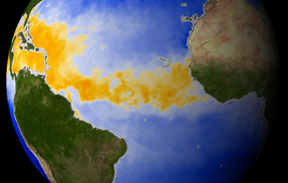|
News Notes
Climate
Stormy debate on hurricanes and global warming
 Hurricane
season is here again, and while forecasters say it should not be a repeat
of last year’s record-breaking storms, they do expect an above-average
season. Given that forecast and the last two years’ worth of major
hurricanes, some people have been wondering whether the stronger storms
are the result of global warming.
Hurricane
season is here again, and while forecasters say it should not be a repeat
of last year’s record-breaking storms, they do expect an above-average
season. Given that forecast and the last two years’ worth of major
hurricanes, some people have been wondering whether the stronger storms
are the result of global warming.
In this satellite image, orange colors indicate sea-surface temperatures warmer than 28 degrees Celsius (82 degrees Fahrenheit), which are necessary for hurricane formation. Researchers are debating about whether rising sea-surface temperatures are causing stronger hurricanes. Image is courtesy of NASA GSFC.
Last year, several studies linked rising sea-surface temperatures — possibly caused by increases in atmospheric greenhouse gases — to increased hurricane intensities. But new research is suggesting that warming may not be to blame.
Over the past couple of decades, the world’s oceans have warmed, while simultaneously experiencing increasingly more and stronger hurricanes, says Paul Knappen-berger of the University of Virginia in Charlottesville, co-author on the new research in the May 10 Geophysical Research Letters. “The great debate ongoing right now” in hurricane research is whether the increasing numbers and intensities of hurricanes and the warming over the past few decades “is a natural oscillation or is anthropogenic,” he says.
Although the number of storms has increased recently, likely because of natural variation, some researchers have suggested that the rising intensities and chances of reaching Category-4 and -5 status have increased proportionally with sea-surface temperatures (see Geotimes, December 2005). Publishing in several separate studies last year, Kerry Emanuel of MIT in Cambridge, Mass., and Peter Webster of Georgia Tech in Atlanta and their colleagues used observations from hurricanes over the past several decades to show that rising sea-surface temperatures in tropical basins were causing, in large part, stronger, more intense hurricanes.
To test this link, Knappenberger and University of Virginia colleagues Robert Davis and Patrick Michaels, who is also with the Cato Institute in Washington, D.C., have reexamined the direct relationship between local sea-surface temperatures and hurricane intensities. They compared locally measured sea-surface temperatures and wind speeds from storm reports taken every six hours during 270 named storms’ treks across the tropical Atlantic from 1982 to 2005.
The researchers found that the hurricanes’ peak wind speeds usually were not coincident with where the storms encountered maximum sea-surface temperatures, suggesting that maximum sea-surface temperatures do not directly correspond with hurricanes’ peak intensities. Like Webster and Emanuel, the researchers did find a statistical correlation between storm strength and rising sea-surface temperatures, but only to a point, Michaels says. Once temperatures rose above a threshold — 28.25 degrees Celsius, or 82.85 degrees Fahrenheit — they no longer accounted for a further intensity increase, he says.
Sea-surface temperatures in the Gulf of Mexico reach that threshold early in the summer and stay that high. Thus, Michaels says, “this idea of ‘let’s blame Hurricane Katrina on global warming’ becomes harder to accept.” Linking stronger hurricanes to global warming, he says, is “just too simplistic.”
Another issue must be at play in creating the stronger storms, Michaels says, such as decreasing wind shear — the amount of change in the wind’s direction or speed — which is likely caused by natural oscillations, not global warming. Declining stability in the atmosphere may also be a factor, Knappenberger adds, as was suggested in a paper in Science in April by Webster and colleagues. Michaels and colleagues are currently examining the same dataset to see if they can directly correlate wind shear or atmospheric stability decline with peak hurricane intensities.
“Our profession has known for decades that a particular storm,” Emanuel says, “is affected by wind shear — that’s not news.” But Michaels’ team’s paper “makes the leaping non sequitur that wind shear is the only thing affecting hurricane intensity for any given storm, which simply isn’t true,” he says. In the big picture, sea-surface temperatures are very important in hurricane intensity, he says.
Still, much more research needs to be done to resolve this debate, researchers agree. Most computer models are “far too coarse, with grid points set 20 kilometers apart instead of 2 kilometers,” Emanuel says. Computational points more closely spaced together are necessary to better simulate what’s happening in the eye of a hurricane, he says.
Researchers can also look to the past, Emanuel says, using geological proxies such as fossils or overwash deposits in coastal sediments to determine the extent and possible intensities of ancient hurricanes. Such work can help researchers flesh out what’s natural and what’s not.
Megan Sever
Links:
"Global climate
affects storms?" Geotimes, December 2005

 Subscribe
Subscribe

